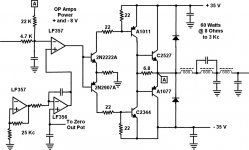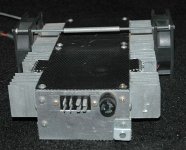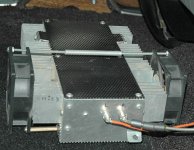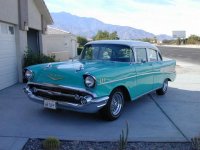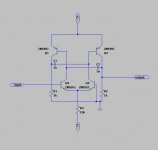TPA3122d2 whining
I've just built my first class D amp with two TPA3122d2 ICs in BTL mode. The layout is based on the evaluation module design from TI, but I squeezed two amps on the same board. It works well, but one of the channels has a high-pitched whine that gets louder when increasing the gain.
The whine continues when unplugging the power, while the amps run on the tiny bit of juice left in the decoupling caps, so the PSU is not the cause. After some more debugging I found that my first design isn't as good as I hoped and the whine is actually caused by RFI. If I disable the other channel, the whine is gone.
I made the mistake of placing the signal traces way too close to the inductors and output pins of the other channel, even though I knew it was a bad idea. I ignored my common sense due to laziness: by routing the signal traces this way on the cramped board, I needed less jumper wires. I had hoped that nearby ground traces would adequately shield the signal traces, but now I learned this is not the case. The TPA3122d2 switches at about 250kHz, and the coils (despite being shielded) and output pins transmit some of this ultrasonic signal to the nearby traces. This signal becomes the audible whine in the other amp due to intermodulation, because the amps don't switch at exactly the same frequency. The good news is that it's only really noticeable at high gain and I'm going to use the amp in an experimental mini-subwoofer anyway that's physically unable to reproduce trebles, so I don't need to try fitting a lowpass filter or worse, redo the board
So, even though you should already know this, it can't hurt to stress it again: keep signal traces as far away from the outputs of class D amps as possible!
I've just built my first class D amp with two TPA3122d2 ICs in BTL mode. The layout is based on the evaluation module design from TI, but I squeezed two amps on the same board. It works well, but one of the channels has a high-pitched whine that gets louder when increasing the gain.
The whine continues when unplugging the power, while the amps run on the tiny bit of juice left in the decoupling caps, so the PSU is not the cause. After some more debugging I found that my first design isn't as good as I hoped and the whine is actually caused by RFI. If I disable the other channel, the whine is gone.
I made the mistake of placing the signal traces way too close to the inductors and output pins of the other channel, even though I knew it was a bad idea. I ignored my common sense due to laziness: by routing the signal traces this way on the cramped board, I needed less jumper wires. I had hoped that nearby ground traces would adequately shield the signal traces, but now I learned this is not the case. The TPA3122d2 switches at about 250kHz, and the coils (despite being shielded) and output pins transmit some of this ultrasonic signal to the nearby traces. This signal becomes the audible whine in the other amp due to intermodulation, because the amps don't switch at exactly the same frequency. The good news is that it's only really noticeable at high gain and I'm going to use the amp in an experimental mini-subwoofer anyway that's physically unable to reproduce trebles, so I don't need to try fitting a lowpass filter or worse, redo the board
So, even though you should already know this, it can't hurt to stress it again: keep signal traces as far away from the outputs of class D amps as possible!
Maybe the second oldest design?
I built this thing around 20 years ago. It still works. I just thought maybe somebody would be interested in an Old School design. FETs at the time I couldn't get to work right, so all is bipolar transistors and J-Fet Op Amps. Power supply does have 2 of those TO-3 BUZ things driven by a transformer. It is for Bass at cutoff of 500 Cy, but is actually good to 3 Kc. 60 watts a channel. It is unstable without a load. I use it to drive a pair of Eminence 18 inch woofers in my 57 Chevy. Also posted this in the photo gallery.
I built this thing around 20 years ago. It still works. I just thought maybe somebody would be interested in an Old School design. FETs at the time I couldn't get to work right, so all is bipolar transistors and J-Fet Op Amps. Power supply does have 2 of those TO-3 BUZ things driven by a transformer. It is for Bass at cutoff of 500 Cy, but is actually good to 3 Kc. 60 watts a channel. It is unstable without a load. I use it to drive a pair of Eminence 18 inch woofers in my 57 Chevy. Also posted this in the photo gallery.
Attachments
I seem to recall studying an article about constructing a bipolar transistor classD design. I think it featured in a 1966 edition of Electronics World. Probably not really HiFi, but interesting nonetheless. There seemed to be a stir of interest in classD around that time. Letters & Circuit Ideas In Wireless World/Electronics World.
i have a copy of the EEE magazine "Electronic Design Handbook" from 1965. a very simple class D amp (called a "bang-bang" amplifier in the article text) is on page 93. i thought i had scanned this image in when my scanner was working, but i have not been able to find the file. so i just did a copy of it in LTSpice. it's a free running PWM. the input requires a 0.7V bias to operate "linearly", and the output needs to be capacitively coupled. feedback can be coupled through an RC filter back to the input (so it's an inverting amp). the article claimed linearity with feedback to be within .0025 percent. maximum input swing is 100mV for a 20V output swing. correction, i modeled this in ltspice, input zero bias seems to work better. but a 100mV swing seems to "clip" the amp
Attachments
Last edited:
Hmm, based on all the fun published class D amp designers have apparently had getting their designs to work reliably, this is clearly a Ninja Engineer class project. I can refer you to available info from Bruno Putzeys (responsible for a lot of Philiips diesigns) and Rod Elliot (an Australian who knows a whole lot about amp design and shares it very well indeed). Even having read this and a whole bunch more stuff about diy class D, I feel hopelessly outclassed in terms of trying one myself. Much easier to get on the Parts Express website and order one!
On this forum!Hi,
Anyone an idea where to look?
It's tough. I've been working on one based off a PWM design for a year now and it's kicking my butt. I've got a prototype in the other room that plays, but doesn't sound too good and has a problem with ultra-low frequencies on the output. One of the few amp designs you'll come across that pass the signal through nand gates and optocouplers. On the upside, I think I have designed a successfull output stage for it. (Gotta take pride in the small victories.)
Dear TJNII,
I read your Class D revive, I am from Srilanka, and very much to Hi, Fi Audio. I know very little about Class D, OK I bought a module Zap 800 XE, from LC Audio Denmark, along with the soft start, power supply module with out the transformer. I hooked it up with the transformers I have (30 V Plus 0 volt Minus 10 Amps) I have a problem, on high Bass peaks, the whole thing stop!! I cannot start it up again, but after a while say few minutes it can start again!!?? I am using Cervin Vaga 4 way speakers. Can you please be kind enough to help me in how I should tackle this problem, please. I have written to the manufactures about twice, but no reply.
I have spend one whole months saving to this project, I know its very difficult to exactly pin point the problem but as you are an experience Class D constructor I am sure you can just tell me some thing to help me.
Kindest Regads
Leonard Fernando. ( oz6zv@yahoo.com)
Would be interested to hear comments on this article:
http://www.hificritic.com/downloads/Class-D.pdf
Anthony
Interesting and written by an analogue person. Some points are good and valid, reference frequency responses of output inductors and DC levels on loudspeakers. The latter, being a Class 2 installation, is not a problem as long as the user is aware of the possible voltages. The main issue I have with the Hypex 400 unit is the poor quality HF choke that runs very hot.
Would be interested to hear comments on this article:
http://www.hificritic.com/downloads/Class-D.pdf
Anthony
Personally I am also an audisotheric believer and multiple comments of the article fit to my religion - nevertheless the compressed amount of these statements in the article is stunning.
Also the article criticizes lots of short comings, which are true in many available designs just because many available designs are simply quick and dirty.
Especially: Unstable behavior without load, strong load dependency of treble reproduction, poor clipping behavior.
Class d the pitfalls.
I had a go at a irs2092 based design.
So I threw together a single channel pcb and it didn't work.
Just kept resetting all the time even with a small signal in.
So I went back to the drawing board.
I started adding close decoupling to the mosfets and the 2092.
This helped a bit and I could get a moderate signal in before resetting started.
I reworked the pcb again keeping tracks as short as possible and components close to each other. I also added a ground plane.
Then I got a clicking through the audio, I traced this down to the VCC 12 volt regulator not being decoupled properly.
I then got huge thumps through the speaker on turn off. I traced this down to the 20,000uf caps I had in the power supply upsetting the 2092.
So I added a small PIC microcontroller to monitor the VCC and hold the 2092 in reset if it drooped below 15 volts on the input to the regulator. This was recommended by IR.
I then designed a stereo pcb. However I didn't put enough effort into getting everything as good as the previous mono pcb and it reset on high powers. I traced this down to layout and I found the gate driver transistors needed 10uf on each close to the transistors.
I had a go at a irs2092 based design.
So I threw together a single channel pcb and it didn't work.
Just kept resetting all the time even with a small signal in.
So I went back to the drawing board.
I started adding close decoupling to the mosfets and the 2092.
This helped a bit and I could get a moderate signal in before resetting started.
I reworked the pcb again keeping tracks as short as possible and components close to each other. I also added a ground plane.
Then I got a clicking through the audio, I traced this down to the VCC 12 volt regulator not being decoupled properly.
I then got huge thumps through the speaker on turn off. I traced this down to the 20,000uf caps I had in the power supply upsetting the 2092.
So I added a small PIC microcontroller to monitor the VCC and hold the 2092 in reset if it drooped below 15 volts on the input to the regulator. This was recommended by IR.
I then designed a stereo pcb. However I didn't put enough effort into getting everything as good as the previous mono pcb and it reset on high powers. I traced this down to layout and I found the gate driver transistors needed 10uf on each close to the transistors.
i've been in the audio repair business for over 40 years, and have been able to keep a good eye on the industry.... here's what i see with class D stuff, and this is just my opinion.... 90% of the class D equipment is made with NO negative feedback, and the sound quality is terrible (a lot of this is "low end" samsung, sony, panasonic, LG bargain doo-doo). the lack of negative feedback renders a high output impedance, which interacts with the cheap speakers. Pioneer makes a nice product (using Bang & Olufsen ICE amps) which actually sounds good and has decent reliability (the ICE amps have negative feedback, very high switching frequency, and adequate protection circuits). i have not yet had a chance to measure the output impedance of a Pioneer ICE amp, but i'm sure it's at least as low as 100 milliohms (more data to come....). not sure if my measurement setup would work well with the "floating" outputs of the low end stuff (without letting out the "magic smoke").... just my opinion of course, but the majority of good consumer equipment continues to be class AB with heavy iron in the power supply...... Harman Kardon receivers with PWM ("ultralight") power supplies (but still class AB amps) seem to be a high failure item......
This is why I stick to the irs2092.
Discrete class d can get upset on overloaded inputs and cause the upper mosfet to lose its power supply. This causes the mosfet to go into linear mode and blow or overheat.
I did originally design a discrete class d amp. It hummed as it had no feedback.
Discrete class d can get upset on overloaded inputs and cause the upper mosfet to lose its power supply. This causes the mosfet to go into linear mode and blow or overheat.
I did originally design a discrete class d amp. It hummed as it had no feedback.
btw, the average class AB consumer receiver amplifiers have a damping factor between 80 and 200 (at the speaker terminals, which includes the internal wiring and speaker relay contacts).... this is based on measured output impedances between 40 milliohms and 100 milliohms. i think i have a solution to the problem of measuring the output impedances of floating outputs (which are also bridged outputs along with the inherent DC offset of 1/2Vcc) and that is to couple the signals through a capacitance large enough to present less than a milliohm of reactance at the test frequency..... i really should do this at home, since i know i won't get time to do this at work..... we're coming up on our busy season, and already i'm getting hammered with increased volume from "post black friday" repair work.... if i had thought of doing some of these experiments during the slow season, i would have had much better opportunity to fill in some of this data..... as it is now, i'm lucky to get time to tie my shoes.....
Glad to read your vote of confidence for the B&O ICE amps. I discovered/learned of them a few years back when I purchased a Pioneer Elite SC-05 HT receiver. I was literally blown away by their sound. Smooth and silky is how I like to describe it. It was a vast improvement over what I had been use to. Of course, it my first investment in the Pioneer Elite brand. I've been very happy ever since. I've been so enamored with the ICE Power amps, that I gave myself a little Teac integrated amp for Christmas. It too is based on the ICE Power amps modules. I have not done any extended critical listening yet with it, but it sounds as good as expected. Not quite up to the Pioneer implementation, but then neither was the price.i've been in the audio repair business for over 40 years, and have been able to keep a good eye on the industry.... here's what i see with class D stuff, and this is just my opinion.... 90% of the class D equipment is made with NO negative feedback, and the sound quality is terrible (a lot of this is "low end" samsung, sony, panasonic, LG bargain doo-doo). the lack of negative feedback renders a high output impedance, which interacts with the cheap speakers. Pioneer makes a nice product (using Bang & Olufsen ICE amps) which actually sounds good and has decent reliability (the ICE amps have negative feedback, very high switching frequency, and adequate protection circuits). i have not yet had a chance to measure the output impedance of a Pioneer ICE amp, but i'm sure it's at least as low as 100 milliohms (more data to come....). not sure if my measurement setup would work well with the "floating" outputs of the low end stuff (without letting out the "magic smoke").... just my opinion of course, but the majority of good consumer equipment continues to be class AB with heavy iron in the power supply...... Harman Kardon receivers with PWM ("ultralight") power supplies (but still class AB amps) seem to be a high failure item......
On the DIY side of things.... I have built quite a few other class D amps using various modules from China. Some more well-known than others (IRS2092) in particular. I think their sound is over-all pleasing, with an emphasis on the mid and high freqs. To me they have a very open and dynamic sound which allows me to hear things I never heard before. However, I have not been able to replicate the ICE amp module sound, but in general, I like the the class D sonic signature. Perhaps my old ears are playing tricks on me.
It's always good to hear from someone who's been on the 'front lines' so to speak of this business and has seen a lot of makes and models cross their bench over the years and been able to test/hear the sound of so many different types and classes of amplifiers.
The whole power nonsense is overrated, class d is just used cause it's cheap . I'd rather take a avera power for a sub and remove the ****** components and lower the emi rfi etc+ matching the amp to your sub and match it as good as possible . 100 watt rms is a lot for inside used if you have a clean sound and low distorton etc. All the power talk is useless, class d just is far from perfect. Most u its are nice for in a crazy man, with 1500watts in his car and it's around for years and years, but indeed is the inuke , when you watch what a nice alumium box costs, aint expensive. I prefer weight with just full a/b since i know what the end of my build will be. just buy the 1500w class d for 350 euro.... way easier and a lot of people are amazed(your neighbours will be).. . fgreets
. fgreets
- Home
- Amplifiers
- Class D
- Class D Design Issues
